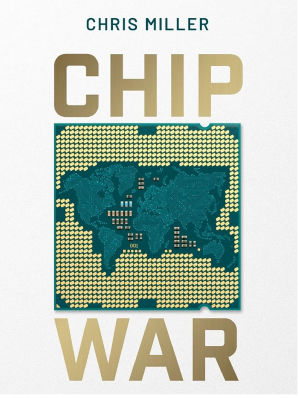
Chip War
By Chris Miller
Score: 5/5
I've finished reading Chris Miller's Chip War, the history of the semiconductor industry. This is one of the best books I've read for a long time. It is much more than just a history though.
Semiconductors are a (perhaps the) foundation of modern life and are now present in almost everything manufactured, not just computer processors (CPU's). Also chips for networking (including wifi), communications, manufacturing, medical, power. And weapon systems.
So from the physics, to the engineering, manufacturing, supply chains and logistics, we have an essential technology, globalised and now wrapped up in "Great Power" competition. The book is almost up to date and climaxes with the US/China rupture over trade and technology, with the US now awake to the Chinese threat to their continued technological domination. It is almost gripping.
The technology now used to create these devices is breathtaking. Arthur C. Clarke's said :
Any sufficiently advanced technology is indistinguishable from magic
Reading this book, particularly the chapter on the Extreme Ultraviolet (EUV) Lithography process, brought this old quote to mind on a few occasions. The world is full of "magical" technology today but we barely recognise it as such because we are so used to it.
One scientist called the development of EUV as "what felt like infinite money for solving an impossible problem". This research had been going on for decades and some people didn't think it was actually possible. The scale of the latest transistors (the building block of everything) was getting so small (tens of nanometres (nm)) that the wavelength of light needed to "etch" them was also getting so tiny that quantum effects can cause problems. Some very advanced science is needed today at the cutting edge.
For instance: just producing the light needed for the process now is very difficult. This development originated with a US company called Cymer; experts in laser light sources. From the book :
The company's engineers realised the best approach was to shoot a tiny ball of tin measuring thirty-millionths of a meter wide moving through a vacuum at speeds of around two hundred miles per hour. The tin is then struck twice with a laser, the first pulse to warm it up, the second to blast it into a plasma with a temperature around half a million degrees, many times hotter than the surface of the sun. This process of blasting tin is then repeated fifty-thousand times per second to produce EUV light in the quantities necessary to fabricate chips.
Approaching magic? Well, we're certainly getting close.
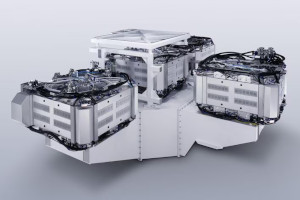
This laser had to be designed and built: it didn't exist. This in itself is a marvel of engineering. The people that built it: a German company called Trumpf. Their web site includes a picture of this (shown on the right).
The actual EUV machine itself is built by a Dutch company called ASML. The technology involved is well described on their own page. It is one of the most complex machines ever built and not only very expensive (we are talking hundreds of millions dollars) but increasingly wrapped up in the new hard rules on export imposed by the US.
Below: The ASML EUV Lithography system :
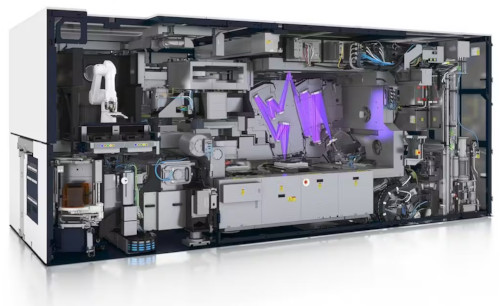
Although the likes of the Taiwan Semiconductor Manufacturing Company (TSMC) are the undisputed kings of silicon chip fabrication in 2023 (and this is unlikely to change in the near or even medium term), the USA still has a huge amount of leverage over the industry and many chip "choke" points. The dilemma is that Taiwan, like South Korea and Holland, are allies of the US, so to target China or claw back manufacturing onshore, means treading a very fine line.
The consequences of a Chinese war for Taiwan would likely be absolutely disastrous for the world due to the impact on the the silicon chip supply. Not just logic chips, but memory and NAND (flash) as well. A severe impact which will affect everyone very badly. This is a dangerous piece of history playing out right now, and as Miller says in the book, Taiwan is the "beating heart of the digital world".
Great book.
Over the years, you see and recognise the same painters and can watch them get better over time. Some artists paint in a very realistic style, which is impressive from a technical point of view and sometimes also produces a beautiful work of art. Occasionally, a "hyper real" style can seem too much like a photograph and this is probably a common criticism. My take is that the ends justify the means and if the ends look like this work by Lucy McKie then I'm very glad to see it. Colour, composition and technique come together to create something beautiful.
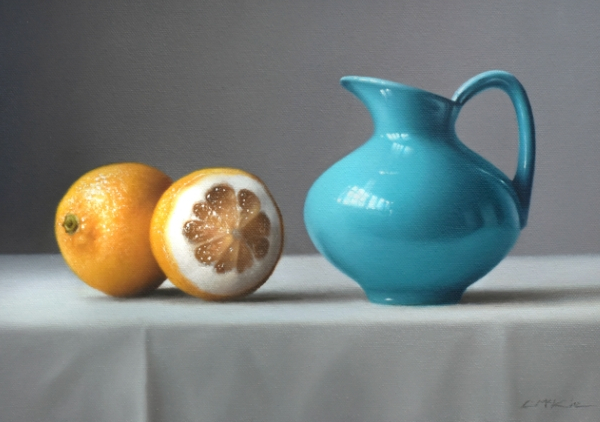
Above: Blue Jug with Two Lemons, Lucy McKie, 25 x 35 cm, Oil.
You can see this work at the Mall Galleries site. Make sure you look through the rest of the Royal Institute of Oil Painters 2023 exhibition to see much more by some great artists.

I'm reading the book Chip War by Chris Miller, about the history of the semiconductor industry. It looks at technology, logistics and at the increasingly fraught politics of the manufacture of advanced computer chips.
I know some of the history here, especially from a Silicon Valley and USA perspective, but there's plenty I'm learning (and I am only a quarter of the way through the book). A trivial example: I'd never thought of the origin or meaning of the term computer "chip". It turns out that it's from the way the integrated circuits were all created on a single piece of silicon and then each individual circuit was "chipped" off the whole to make the part.
A huge amount of very innovative work was done in the semiconductor and transistor field in the fifties and sixties and it continues to this day. The technology is, in some ways, almost indistinguishable from magic.

I went to see the new National Gallery of Scotland exhibition The Printmaker's Art | Rembrandt to Rego. Printing is both art and craft, and here you often need to make the tool to then make your art. For instance, etching a copper plate or sanding a stone block for lithographic printing. The exhibition has some good videos showing a few of the printing techniques available to an artist (the videos are also on their YouTube channel).
There are some very good prints on display here, some phenomenally good. An example of the latter is Claude Mellan's Head of Christ, an engraving printed on paper.
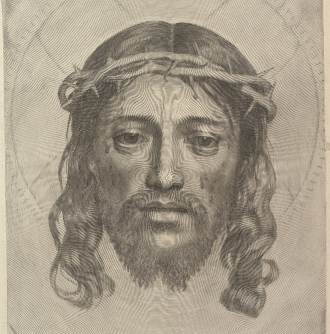
As the information in the gallery box says :
"Incredibly, this entire image has been formed using a single engraved line swirling outwards from the tip of the nose."
Right: Face of Christ on St. Veronica's Cloth, Claude Mellan, 1649. Engraving; second state of two.
NOTE: The image is taken from The Metropolitan Museum in New York. To properly see the amazing print, you need to see it in person or, at least, go to the Met link.
There is a whole other side to Rembrandt's artistic output: printmaking. He was a master of the art and the exhibition has an example of this in his print Christ Presented to the People ('Ecce Homo'). The gallery shows two versions, a later one he reworked, showing his mastery of the Drypoint printing technique. The print is made by using a needle or sharp object to directly incise the lines in a metal plate. The Met Museum has an essay about this.
The image below is from the National Gallery of Scotland web site.
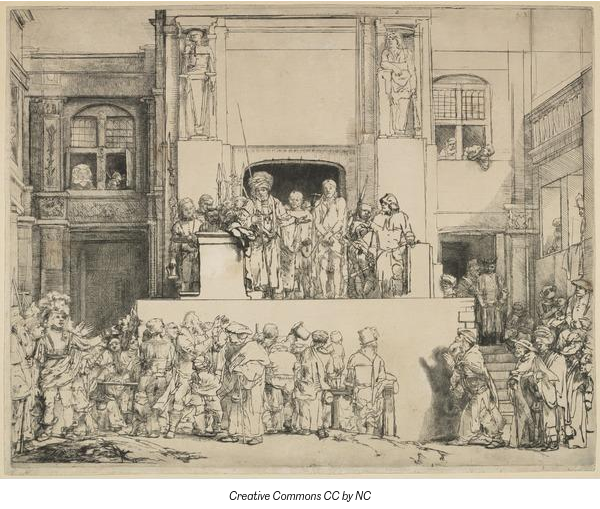
Above: Christ Presented to the People ('Ecce Homo'), Rembrandt, 1655, Drypoint.
An unfamiliar name to me, Joan Hassall produced a print called The Stricken Oak that is absolutely amazing.
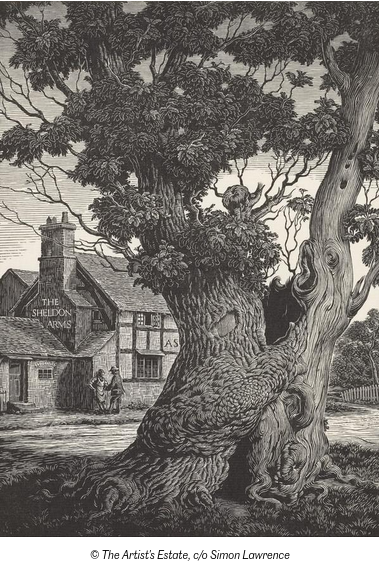
Shown on the right, it should be seen in all its glory, either in real life or the National Gallery of Scotland web site. A beautiful and very finely detailed wood cut.
Right: The Stricken Oak, Joan Hassall. Wood engraving on paper, 1937 [link].
There are a lot of pieces worth seeing and this only scratches the surface. We also have William Blake: tiny wood engravings illustrating Thornton's Pastorals of Virgil (see the Tate site).
Hokusai, Otto Dix, Toulouse-Lautrec, Degas, Picasso, Goya, Constable and more.
I'm a member of the National Gallery of Scotland so it is an easy decision to go back for another look. However, even if I wasn't a member, I think another visit would be hard to resist.
Printing has been something I have wanted to try my hand at for a long time and this is another little push to have a go sometime.
I rarely think about using a spell-checking program: I've always thought I was fine reading what I wrote and fixing any mistakes myself. I can spell. But the other day, reading back a short blog post (again) I noticed a couple of errors I should have seen earlier. I could easily have "published" them. This made me think about a vim spell-checker.
It turns out there is a very easy way to do a spell-check in vim:
:set spell

This highlights words considered misspelled. There are keys to jump between them and
also to pop open a list of suggestions (see: :h spell).
A very useful tool on occasion. I must remember to use it before pushing anything out to the world!
There are lots of different things going on in December: markets, fairs, shows, exhibitions, concerts. Too much to see everything so you have to be a bit picky. Unfortunately, a lot does tend to clash at weekends.
A case in point last weekend were so many artist studio spaces having an "open studios" at the same time: Coburg House, Patriothall and Out of the Blue Abbeymount. I wanted to see Abbeymount Studios (I've never been) but prioritised Patriothall because it is near me and I was a bit time constrained. All this was on top of Out of the Blue Arts Market, Summerhall Christmas Market and quite a few other markets. All go!
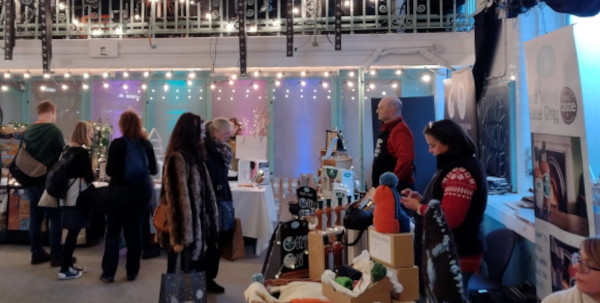
I went to Summerhall Christmas Market on Saturday afternoon and thoroughly enjoyed wandering around the stalls in all the various rooms of the rambling old building. Until 2011 it was "The Royal (Dick) School of Veterinary Studies" but now it's a big arts venue with a lot of very diverse programming.
The best thing about well curated markets like Summerhall is the quality of the stallholders: creators and makers. Much to see and many are worth drawing attention to but I'm always particularly interested in any visual artists around.
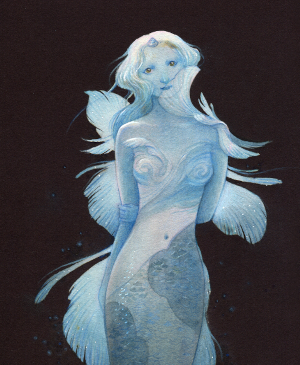
Marie-Alice Harel
One of the creators present was Marie-Alice Harel, an artist and illustrator.
I recognised her work from a book I'd seen at Transreal Fiction, a self-published art book called Bird People.
As she says on the web page, it certainly is "curious": "a reflexion on nature and culture, on the blurry line between human and animal". Her art is fine, detailed and beautiful to look at, in the classic tradition of Edmund Dulac. She's won some awards and exhibited quite widely. There's lots on her web site, including some process. More to come I expect!
Left: A detail from Into the Deep, Watercolor and ink, 2020. © MÄ HAREL [link]
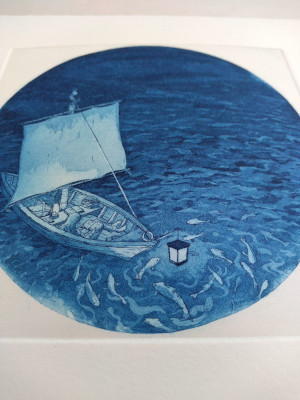
Joanna Robson
Another artist and illustrator with a table exhibiting her work was Joanna Robson.
Robson's also an accomplished artist with an attractive body of work. I was particularly struck by the prints she had on display.
The etching Haven has a blog post describing the background and technique. Having recently visited the Scottish National Gallery's The Printmaker's Art, it's great to see the actual copper plate the etching is inscribed on. It looks beautiful.
Right: Haven, etching. © Joanna Robson [link]
Overall, an excellent Christmas market at Summerhall, made so good by the people taking part. I will definitely want to go next year as well. I also bought some Kimchi from Edinburgh Fermentarium. I've now finished the pot of "Mac Kimchi" : "A kimchi for those of us who crave the deep spicy umami of traditional Korean kimchi". Recommended.
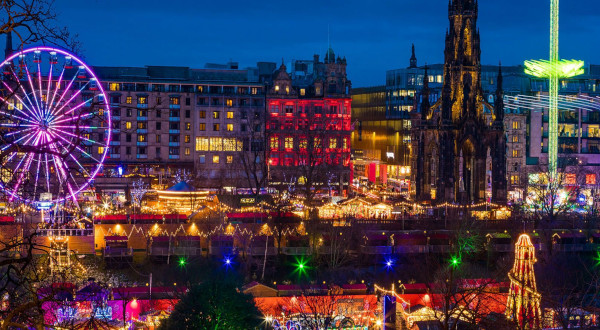
Well, tis the season to go shopping it seems.
Edinburgh is jam packed with people in the town center. I read that the official Christmas Market on Princes Street is unbearably busy, with some people turning around and walking away because of the queues. Even outside the main areas things are busy, especially at weekends. Luckily, I'm an early bird so, if I need to go near the epicentre, I can mostly avoid the crush. I assume it will be getting worse.
It's definitely something to take in at night though. I like this time of year because of the number of things to do but I prefer the smaller and less commercial attractions. Some reports to come hopefully.
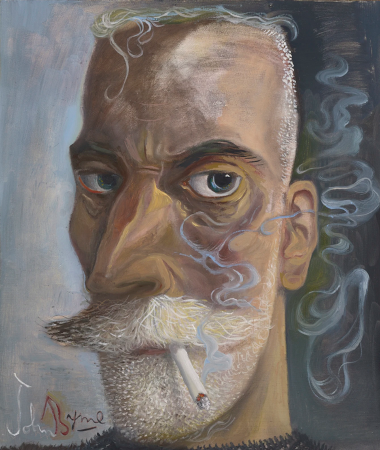
Above: Biggish Self Portrait, John Byrne. Oil on Board. 61x71cm
John Byrne, one of the best artists Scotland's produced, died today. He was a natural : he had to draw (write,paint) to live.
I was mostly familiar with his painting, drawing and print making and he was very prolific. In addition to this, he was a successful writer and playwright.
Definitely a big Byrne-shaped hole in the Scottish arts scene.
I saw a lot of his work over the years in Edinburgh, and would even occasionally see the man himself around town (or in the Art Shop). A very dapper dresser. He was fond of doing self-portraits, often with a cigarette in his mouth: not very good for his health although he lived to a good age (like another famous artist smoker, David Hockney).
Although I'll miss seeing new art works from him, I look forward to a proper retrospective exhibition.



